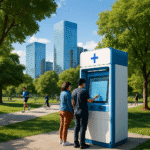Key Takeaways
- The deployment of logistics robots at Mitsui Outlet Park Kisarazu is less a retail novelty and more a direct, pragmatic response to Japan’s severe demographic pressures and the acute labour crisis in its logistics sector.
- Choosing a high-traffic, semi-structured public environment like an outlet mall over a controlled warehouse represents a significant escalation in testing the real world viability and social acceptance of autonomous systems.
- This initiative is not an outlier but part of a broader, systemic push towards automation across Japanese commerce, evidenced by parallel investments from major corporations like Mitsubishi in similar last mile delivery robots.
- The ultimate measure of success may not be direct cost savings but operational resilience; the ability to maintain fluid internal supply chains regardless of human labour availability, potentially creating a new metric for valuing commercial real estate.
The recent deployment of NBIS autonomous robots at Mitsui’s Kisarazu outlet mall is a deceptively significant event. While on the surface it appears to be a modest operational trial, it serves as a potent indicator of the immense pressures confronting the Japanese economy. This is not an experiment in retail technology for its own sake; it is a calculated response to a demographic reality, specifically the critical labour shortages that threaten to paralyse the country’s logistics and service sectors. The partnership with autonomous mobility specialist Avride to manage internal logistics in one of Japan’s largest and busiest retail environments offers a glimpse into a future where operational continuity is decoupled from population decline.
A Necessary Response to the ‘2024 Problem’
To understand the context of the Kisarazu deployment, one must look beyond the retail sector and towards Japan’s broader economic challenges. The country is grappling with what has been termed the ‘2024 Problem’, a set of new government regulations that cap overtime hours for truck drivers. While intended to improve working conditions, these rules are expected to severely constrict logistics capacity in an industry already hollowed out by an ageing workforce. The Japan International Freight Forwarders Association has warned of widespread disruption, highlighting the urgent need for non human solutions to maintain supply chain integrity.
The nation’s demographic trajectory provides the grim backdrop. Japan’s working age population is projected to fall by nearly 30 percent between 2020 and 2050, according to official government projections. This is not a distant forecast but a present day crisis for labour intensive industries. In this light, automating the movement of goods inside a sprawling retail complex ceases to be a choice and becomes a strategic imperative. The robots at Kisarazu are, in effect, a pilot programme for national economic resilience.
From Controlled Warehouse to Retail Chaos
The decision to test these systems at a location like Mitsui Outlet Park Kisarazu, rather than a closed logistics hub, is particularly telling. A controlled warehouse is a predictable, structured environment, a solved problem for robotics. A premium outlet mall, conversely, is a highly dynamic and chaotic space, defined by unpredictable pedestrian flows, fluctuating delivery schedules, and the need for seamless coexistence with human staff and shoppers. It is a far more demanding proving ground.
Success here would demonstrate that autonomous logistics can be integrated into complex, public facing commercial environments. Failure, whether technical or social, would provide equally valuable data. The collaboration with Avride, a company focused on autonomous mobility solutions, suggests the technical challenge is being taken seriously. The goal is not simply to replace manual cart pushing but to create an intelligent, responsive internal logistics network that can adapt to the mall’s daily rhythm.
A Broader Commercial Automation Gambit
The Mitsui initiative is not occurring in a vacuum. It is indicative of a wider trend among Japanese conglomerates to invest heavily in automation as a long term strategic hedge. This is not limited to internal logistics. For instance, Mitsubishi Corporation recently placed a significant order for nearly 100 autonomous delivery robots from the American firm Cartken, intended for use in commercial facilities and residential areas. This move signals a clear intent to automate the entire last mile, from the distribution centre to the end consumer’s door.
These parallel investments suggest a competitive and accelerating landscape for automation in Japan.
| Corporation | Technology Partner / Provider | Primary Application | Status / Scale |
|---|---|---|---|
| Mitsui Fudosan | Avride / NBIS | Internal logistics at a large retail outlet | Operational trial (2024) |
| Mitsubishi Corporation | Cartken | Last mile delivery (commercial & residential) | Order for 96 units (2024) |
| Japan Post | Various (including Panasonic) | Autonomous mail and parcel delivery | Ongoing public road trials |
Forward View: Beyond Labour Arbitrage
For investors, the immediate takeaway is that the growth narrative for robotics and automation in Japan is shifting from industrial manufacturing to the commercial and service sectors. The enabling technology companies, both domestic and international, stand to benefit from this secular trend. However, the most insightful lens through which to view this development is not one of simple labour arbitrage.
The true value proposition of the Kisarazu trial lies in operational resilience. The ability to maintain perfect stock levels, reduce replenishment times, and free up human staff for higher value, customer facing tasks could directly translate into increased sales per square foot. My speculative hypothesis is this: within two years, the success of these systems will not be judged on headcount reduction, but on their quantifiable impact on revenue and operational stability. This could lead to the emergence of a new valuation metric for commercial real estate assets: an ‘automation intensity’ score, where properties with robust, integrated robotic systems command a premium for their ability to function effectively regardless of labour market volatility. The quiet hum of robots in Kisarazu may be the sound of a fundamental repricing of commercial risk.
References
HyperTechInvest. (2024, October 2). $NBIS Robots Begin Operating at Japan’s Largest Outlet Mall Partnering with Mitsui, Avride will help with internal logistics at their Kisarazu outlet. Retrieved from https://x.com/HyperTechInvest/status/1932164271871349087
Japan International Freight Forwarders Association Inc. (n.d.). The 2024 Problem. Retrieved from https://www.jifanet.or.jp/en/working-style-reform/
National Institute of Population and Social Security Research. (2023). Population Projections for Japan (2023-2070). Retrieved from http://www.ipss.go.jp/pp-zenkoku/e/zenkoku_e2023/pp_zenkoku2023e_gaiyo.html
Robotics and Automation News. (2024, June 26). Mitsubishi orders almost 100 autonomous delivery robots from Cartken. Retrieved from https://roboticsandautomationnews.com/2025/06/26/mitsubishi-orders-almost-100-autonomous-delivery-robots-from-cartken/92655/
JETRO. (2022, November). Success Story: Realtime Robotics, Inc. Retrieved from https://www.jetro.go.jp/en/invest/investment_environment/success_stories/realtime_robotics.html
Time Out. (2024, March 12). Mitsui Outlet Park Kisarazu. Retrieved from https://www.timeout.com/tokyo/shopping/mitsui-outlet-park-kisarazu














